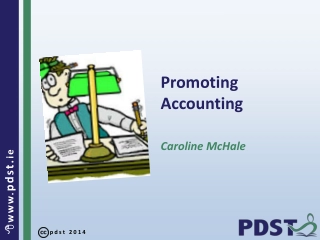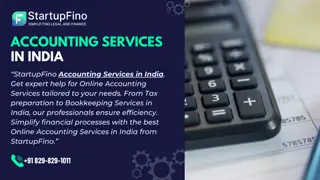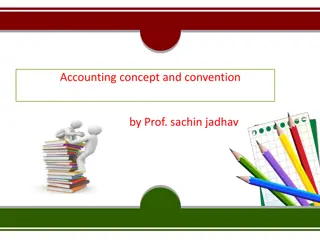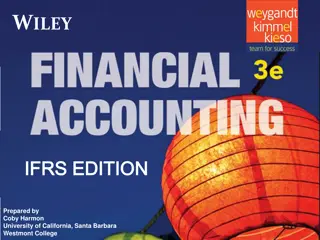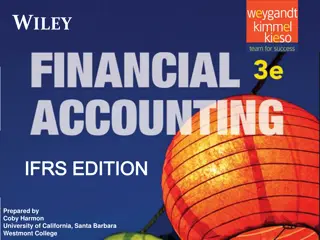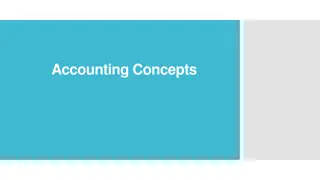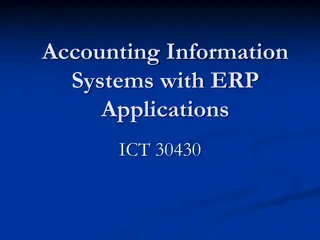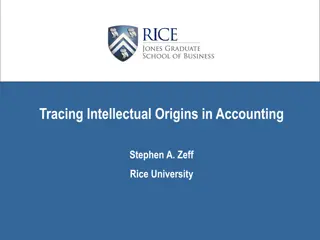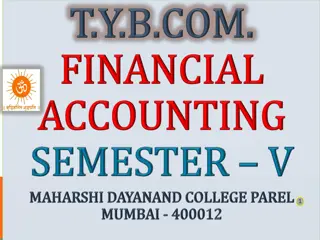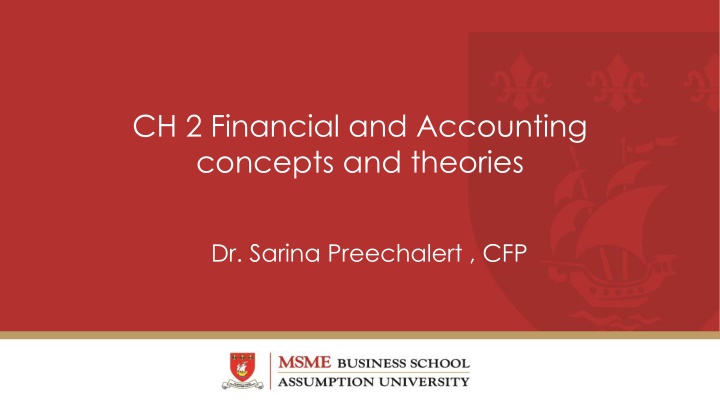
Financial and Accounting Concepts: Economics, Theories, and Strategies
Explore essential financial planning concepts, economics theories, and accounting principles in this comprehensive guide by Dr. Sarina Preechalert, CFP. Learn about microeconomics, macroeconomics, budgeting, investment alternatives, and more to enhance your financial knowledge and decision-making skills.
Download Presentation

Please find below an Image/Link to download the presentation.
The content on the website is provided AS IS for your information and personal use only. It may not be sold, licensed, or shared on other websites without obtaining consent from the author. If you encounter any issues during the download, it is possible that the publisher has removed the file from their server.
You are allowed to download the files provided on this website for personal or commercial use, subject to the condition that they are used lawfully. All files are the property of their respective owners.
The content on the website is provided AS IS for your information and personal use only. It may not be sold, licensed, or shared on other websites without obtaining consent from the author.
E N D
Presentation Transcript
CH 2 Financial and Accounting concepts and theories Dr. Sarina Preechalert , CFP
Outline 1. Economics concepts and Theories Microeconomics Macroeconomics 2. Accounting concepts and Theories Financial information Financial analysis 3. Financial concept and Theories Financial systems and Investment alternatives Time values of Money Risk, Return and diversification Assets Valuation
Introduction Financial planning is like planning your trip to your dream destination. We need to know our current situation , budget, limitation Then find the right route for ourselves . Not only to know from what we have, externalities also important Current economic situation, political issues, etc.
Introduction Personal information Financial planning Externalities
I. Economics concepts and Theories Microeconomics Opportunity cost Law of scarcity Type of economy Traditional economy- Decision is made by tribe or family Command economy-Decision is made by government to produce or serve and to set price to those products and services e.g. Cuba, North Korea Capitalist economy/market economy-Decision is made by individual or those who owns resources / market mechanism will set price and direct production Mixed economy- many countries have mixed economy system.
Economics concepts and Theories Macroeconomies Factors GDP (Gross Domestic Product) value of product and services which have been operated in country for awhile. GDP =C+I+G+(X-M) Where C = Consumption I = Investment G = Government Spending Net Export = X-M X = export M = Import
Economics concepts and Theories GDP refers to financial well-being or wealthiness of population in country. Government wants to increase GDP per capita to induce growth in economy. Government Intervention- government intervene economy system through by intervene expenditure or set up policy through central bank . GDP might not reflect country financial well being due to the lack of other importance factor such as income distribution , pollution index, etc.
Economics concepts and Theories Budgetary balance Definition Difference of budgetary expenses and budgetary income Difference between budgetary expense and budgetary income from internal revenue department Deficit budgetary balance implies that government increase spending and GDP will be increased , employment rate increased, production increased. The effect is a good sign of economy and investor expectation from stock market. *** Long term deficit budgetary balance effects to inflation, public debt and interest will be risen eventually.Inflation rises when government has long term deficit balance.
Economics concepts and Theories Balance of payment Definition- journal to record accounting lists between domestic and foreigners. Current balance Relocated account balance Transfer or donation account Deficit balance of payment effects
Economics concepts and Theories Fiscal Policy Definition policy of government expenditure and revenue collection Policy set through many tools such as tax rate, public debt, etc.
Economics concepts and Theories Monetary policy Central bank Bank of Thailand use interest rate or policy rate to control volume of money in economy. Recession period-unemployment rate rises, gov will injects money into system by reduce required reserved quantity Commercial banks will have more cash left then able to lend more money into the system. Gov. buys back government bonds and reduce fiscal rate/policy rate.
Economics concepts and Theories Expansion economy Tools Reduce cash from system by increase required reserved of commercial banks. Banks reduce loans Issue bonds and sell in market Increase fiscal policy Stock market- negative impact
Accounting concepts and Theories Financial information Financial statement Auditor s report is very important for the company. There are 4 types of auditor s point of view 1. Unqualified Opinion 2. Qualified Opinion 3. Adverse Opinion 4. Disclaimer Opinion Income statement Cashflow statement
Accounting concepts and Theories Financial statements Balance sheet Income statement Cashflow statement
Accounting concepts and Theories Balance sheet shows company position at a certain period. Assets = Liabilities+ Net Worth Net Worth = Assets Liabilities
Accounting concepts and Theories Balance sheet Assets = Resources that own by company or individual which will create benefit or advantages to owner in future.
Type of Assets Current assets Cash on hand and at banks 1. Cash equivalent cash will be received or paid within 3 months 2. Marketable securities cash invested in high liquid securities in secondary or primary markets. Market price will be recorded on balance sheet s date. 3.Account receivable- cash that customer has obligation to pay to company or individuals at certain period. 4. Inventory 5. Other current assets
Type of Assets Fixed assets Long term investment- cash invested in long term more than 12 months with return needed. Investment in associated company- or Investment in subsidiary company. Property, Plant and Equipment- tangible assets that has physical life more than 1 year and use for operational activities and will be depreciated every year. Intangible assets- non-physical assets that has the life of usage more than 1 year such as patent , copy right, logo, disclaimer etc.
Liabilities Current liabilities Bank overdraft, OD Amount of cash in current account that can be withdrawn more than balance. Account payable = debt from buying raw materials from supplier with credit and must repay within 1 year. Notes Payable- Notes that company promises to pay money within 1 year Dividend payable Accrued expenses Other current liabilities
Liabilities and Shareholders equity Liabilities Long-term liabilities Debenture Bond Long term loan Shareholder s equity Paid-in capital- included preferred stock and common stock Retained earning cumulative profit or loss after divided payment
Income statement Revenue- income from sales and others Expenses Cost of goods sold Depreciation expense Selling and administrative expenses Gross Profit EBIT Net income
Cashflow statement Operational cashflows- cash flows from operation Investing cashflows- cash flows from investing in fixed assets Financial cashflows- cash flows that related to sources of funds
Financial analysis Common size Financial ratio analysis Liquidity ratio- current ratio, quick ratio Leverage debt ratio, debt to equity ratio, interest coverage ratio Efficiency ratio- FATO, TATO, Collection period, Inventory turnover period. Profitability ratio- GPM, OPM, NPM, ROA, ROE
Financial concept and Theories Financial system Financial market Financial Institution Financial Intermediary
Financial concept and Theories Money market Financial market Primary market Organized exchange Capital market Secondary market Over-The - counter market, OTC market
Financial concept and Theories Debt market vs Equity market Spot market , future market
Investment alternatives Asset Class Assets which categorized in the same class with same characteristics Real assets vs Financial assets Real assets investor owns real assets by purchase them such as car, real estate , gold. Financial assets Investor owns financial assets by purchase a contracts to own assets indirectly such as bond, stock, derivatives
Investment alternatives Financial assets has more liquidity than real assets Deposit - high liquid, low risk and low return. For transaction motives. Money market instruments 1. Treasury bill 2. Commercial paper, Bill of exchange 3. Negotiable certificate of deposits, NCD 4. Interbank market 5. Repurchase market or REPO
Financial market instruments 1. Common stocks 2.Preferred stocks 3. Warrant 4. Convertible bond 5. Closed-end fund 6. Open-end fund
Financial market instruments Debt instrument 1. Bond Characteristics- fixed income securities 3 risks Default risk Downgrade risk Credit spread risk Interest rate risk Price risk Reinvestment rate risk
Type of bonds Treasury bond State enterprise bond BOT bond Corporate debenture
Alternative investments Derivatives Future SWAP Option ETF Hedge fund Gold Real estate
Time value of Money concept FV =PV(1+i)n PVA= PMT[ 1-1/(1+i)n /i)] FVA = PMT[(1+i)n -1/i] PVA= PMT[ 1-1/(1+i)n /i)](1+i) FVA = PMT[(1+i)n -1/i](1+i)
Case Somchai currently has 500,000 baht. He wants to have 1,000,000 baht within 2 years. If the interest rate is 2.4% compounded monthly, how much does he need to deposit each month?
Case FV = 1,000,000 PV = -500,000 Rate = 2.4% N = 2 years PMT = ?
Case-Retirement Planning Jenny is 35 years old and wants to retire at age of 60. She expects to live until age of 90. Jenny wants to have income of 30,000 baht every month after retirement. How much does Jenny has to save monthly in order to meet her goal? Assumption: Interest rate 3% (0.25% monthly ) Ignore inflation rate.
Case N = 360 I = 0.25% PMT = 30,000 FV = 0 PV =?
Case N = 300 I = 0.25% PV =0 FV = ? PMT =?
Case Example Initial investment 1,000,000 baht wants to increase to 2,000,000 baht in 10 years. What is the rate of return per year? Deposit monthly 50,000 baht in 15 years, interest rate 3% per year . What is the amount to receive in 15 years What is the payment of 4 million baht amortized loan in 20 year ? (rate 6% annually)

